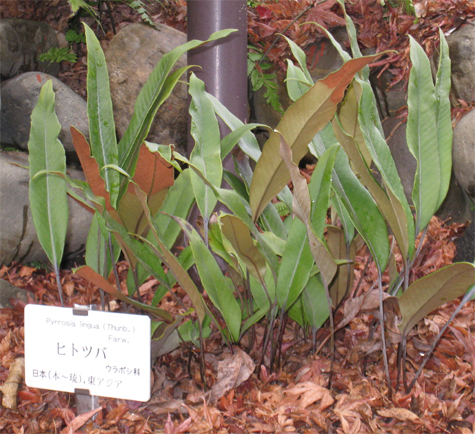| Pyrrosia lingua | ||
Tongue fern, Japanese felt fern | ||
|
Etymology
Lingua means a tongue or tonguelike.
Description
Rhizome: long-creeping, wiry, 3 mm, with phylopodia, scales dense, red to yellow-brown, to 8 mm.
Frond: 30 cm high by 5 cm wide, evergreen, somewhat dimorphic, fertile fronds shorter, narrower, blade/stipe ratio: 1:1 more or less. Stipe: straw-colored to brown, star-shaped hairs dense while young, falling soon; a few scales near the base, vascular bundles: . Blade: simple, ovate, leathery, thick, glossy above, star-shaped hairs on both surfaces when young, becoming glabrous above early, below later. Margins entire; veins appearing free above, but obscurely netted below, difficult to see even with a hand-lens. Sori: round or oblong, ends of veins, becoming confluent, indusium: absent, sporangia: yellow to brown at maturity. Culture
Habitat: on rocks or trees in low mountains.
Distribution: Japan, China, Vietnam.
Hardy to -20°C, USDA Zone 6, perhaps.
Distinctive Characteristics
The felt comes from the stellate hairs/scales on the lower blade surface; in some forms this is sparse and deciduous. There are few simple, entire blades on this site.
Synonyms
Acrostichum lingua Thunb. Polypodium lingua (Thunb.) Sw. Niphobolus lingua (Thunb.) Spreng. Polycampium lingua (Thunb.) C. Presl |
|
|
Notes
Variation There are two botanical forms recognized, one with an acuminate tip and broader blade, not found on the web. There are many cultivars varying in cresting and margins. And there seem to be two very different types, as compared in one of the links; one is highly felted and decumbent, the other glabrous, erect.
Variation There are two botanical forms recognized, one with an acuminate tip and broader blade, not found on the web. There are many cultivars varying in cresting and margins. And there seem to be two very different types, as compared in one of the links; one is highly felted and decumbent, the other glabrous, erect.
